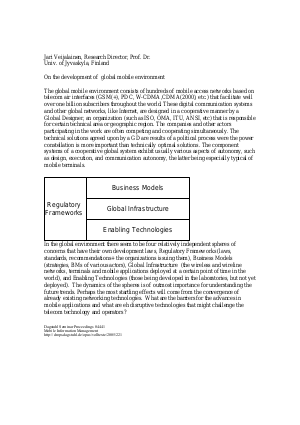On the development of global mobile environment
Author Jari Veijalainen
-
Part of:
Volume:
Dagstuhl Seminar Proceedings, Volume 4441
Part of: Series: Dagstuhl Seminar Proceedings (DagSemProc) - License:
 Creative Commons Attribution 4.0 International license
Creative Commons Attribution 4.0 International license
- Publication Date: 2005-08-10
File

PDF
DagSemProc.04441.11.pdf
- Filesize: 199 kB
- 1 pages
Document Identifiers
Subject Classification
Keywords
- global network infrastructure
- autonomy
- disruptive technologies
Metrics
- Access Statistics
-
Total Accesses (updated on a weekly basis)
0Document
0Metadata
Abstract
The global mobile environment consists of hundreds of mobile access networks based on telecom air interfaces (GSM(+), PDC, W-CDMA,CDMA(2000), etc.) that facilitate well over one billion subscribers throughout the world. These digital communication systems and other global networks, like Internet, are designed in a cooperative manner by a Global Designer, an organization (such as ISO, OMA, ITU, ANSI, etc) that is responsible for certain technical area or geographic region. The companies and other actors participating in the work are often competing and cooperating simultaneously. The technical solutions agreed upon by a GD are results of a political process were the power constellation is more important than technically optimal solutions. The component systems of a cooperative global system exhibit usually various aspects of autonomy, such as design, execution, and communication autonomy, the latter being especially typical of mobile terminals. In the global environment there seem to be four relatively independent spheres of concerns that have their own development laws, Regulatory Frameworks (laws, standards, recommendations+ the organizations issuing them), Business Models (strategies, BMs of various actors), Global Infrastructure (the wireless and wireline networks, terminals and mobile applications deployed at a certain point of time in the world), and Enabling Technologies (those being developed in the laboratories, but not yet deployed). The dynamics of the spheres is of outmost importance for understanding the future trends. Perhaps the most startling effects will come from the convergence of already existing networking technologies. What are the barriers for the advances in mobile applications and what are eh disruptive technologies that might challenge the telecom technology and operators?
Cite As Get BibTex
Jari Veijalainen. On the development of global mobile environment. In Mobile Information Management. Dagstuhl Seminar Proceedings, Volume 4441, p. 1, Schloss Dagstuhl – Leibniz-Zentrum für Informatik (2005)
https://doi.org/10.4230/DagSemProc.04441.11
BibTex
@InProceedings{veijalainen:DagSemProc.04441.11,
author = {Veijalainen, Jari},
title = {{On the development of global mobile environment}},
booktitle = {Mobile Information Management},
pages = {1--1},
series = {Dagstuhl Seminar Proceedings (DagSemProc)},
ISSN = {1862-4405},
year = {2005},
volume = {4441},
editor = {Margaret H. Dunham and Birgitta K\"{o}nig-Ries and Evaggelia Pitoura and Peter Reiher and Can T\"{u}rker},
publisher = {Schloss Dagstuhl -- Leibniz-Zentrum f{\"u}r Informatik},
address = {Dagstuhl, Germany},
URL = {https://drops.dagstuhl.de/entities/document/10.4230/DagSemProc.04441.11},
URN = {urn:nbn:de:0030-drops-2216},
doi = {10.4230/DagSemProc.04441.11},
annote = {Keywords: global network infrastructure, autonomy, disruptive technologies}
}
